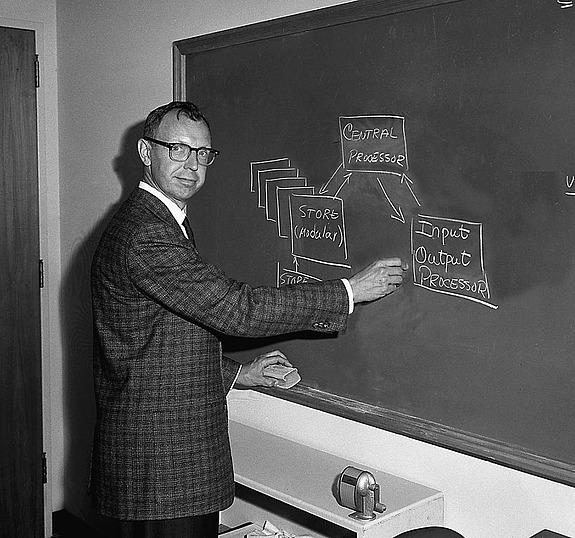Willis Ware: Last of the Original ECP Engineers

Willis Ware accepted a position with the Institute for Advanced Study’s Electronic Computer Project (ECP) on May 13, 1946, and began work on June 1. He was the fourth engineer hired to work on the project—and, at his death on November 22, 2013, was the last survivor of the original engineering team. The working architecture of the modern digital computer—gates, timers, shift registers, all the elements we take entirely for granted including how to implement an adder, not to mention random-access memory and the registers that keep track of it—has Willis Ware’s fingerprints all over it.
He and his friend and colleague James Pomerene were hired by chief engineer Julian Bigelow from Hazeltine Electronics in Little Neck, Long Island, where they had worked on IFF (Identification Friend or Foe) radar systems during World War II. IFF was an implementation, using analogue components, of high-speed digital coding, and was the opposite of encryption. Instead of trying to encode a message that was as difficult as possible to understand when intercepted, the goal of IFF was to transmit a code that would be as difficult as possible to misunderstand. The ability to reliably manipulate high-speed pulses of electrons that Ware and colleagues had developed for IFF was perhaps the greatest technical contribution that anyone brought to the problem of physically realizing, at megacycle speed, what John von Neumann had set out to do, in theory, in late 1945 and early 1946.
Ware was there from the very beginning—starting with the construction of workbenches in the Fuld Hall basement—using “firewood” since wartime rationing of lumber was still in effect. Even scarcer than lumber were apartments, and Ware and Pomerene solved this problem by trading their New York apartments with a couple of Princeton residents who were commuting to work at the United Nations. Ware became the project’s official technical photographer, and his superb documentation of every stage in the construction of the new machine, included in the widely disseminated series of “Interim Progress Report[s] on the Physical Realization of an Electronic Computing Instrument” (starting in January 1947) were instrumental to the immediate and worldwide replication of the IAS design (including its commercial implementation as the IBM 701). Ware and his fellow engineers were well aware that they were forgoing any patents on the inventions they were making right and left, but, continuing in the spirit of wartime cooperation they had started with, they did not object.
About von Neumann, and the origins of stored-program computing, Ware made the now immortal statement that “he was in the right place at the right time with the right connections with the right idea, setting aside the hassle that will probably never be resolved as to whose ideas they really were."
Ware was there at the creation. “I and Akrevoe [Kondopria Emmanouilides, the project secretary, who came to IAS from the ENIAC project at Penn] are the only ones left of the Princeton tribe,” he wrote to me this past year. “If there is any last thing that you need about ECP, now’s the time to ask about it. The hourglass has only a few hundred grains of sand remaining.”
He gave all of us so much.